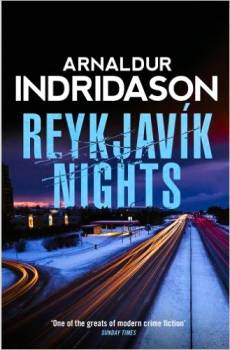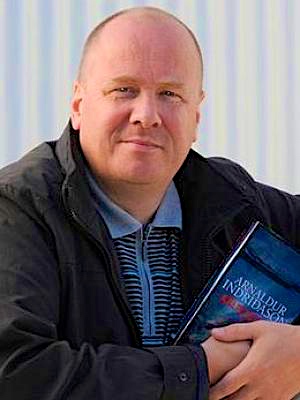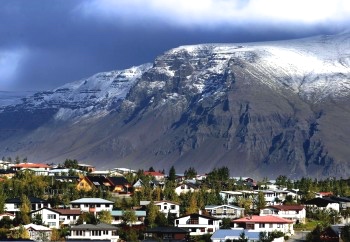Note: Arnaldur was WINNER of the Glass Key award, a literature prize for the best Nordic crime novel, in 2002 and 2003. He was WINNER of the Crime Writers’ Association Gold Dagger Award in 2005 for his novel Silence of the Grave.
“Feeling drowsy, [Erlendur] laid aside the book. His thoughts shifted to the Reykjavic nights so strangely sunny and bright, yet in another sense so dark and desperate. Night after night he and his fellow officers patrolled the city in the lumbering police van, witnessing human dramas that were hidden from others. Some the night provoked and seduced; other, it wounded and terrified…”
 In his first Detective Erlendur novel to be published in English since 2012, Icelandic author Arnaldur Indridason provides a “prequel” to the entire series, now numbering six novels, and flashes back to a time when Erlendur is still in his twenties, establishing some of Erlandur’s background, personality, and youthful history . Here in Reykjavik Nights, Erlendur has just started working for the Reykjavik police, on the night shift, with two young law students who are working part-time for the summer, and he himself is considering whether to take classes at nearby Hamrahlid College which offers adult education classes. Most of his night-time duties consist of breaking up fights, arresting drunks, attending to the victims of automobile accidents, and reporting more serious events – sudden deaths and disappearances – some of which intrigue Erlendur enough that he follows up, unofficially, on his own. Though he does not consider himself “nocturnal,” he does not object to the night duty, having become “reconciled to the city, when its streets were finally quiet with no sound but the wind and the low chugging of the engine” of the van. A loner who has never established strong connections with his peers, and who seems to have no family, Erlendur makes few commitments, a characteristic which becomes even more dramatic in the novels of his later life in which he is almost pathologically solitary, reflecting his grim vision of reality and even grimmer vision of mankind.
In his first Detective Erlendur novel to be published in English since 2012, Icelandic author Arnaldur Indridason provides a “prequel” to the entire series, now numbering six novels, and flashes back to a time when Erlendur is still in his twenties, establishing some of Erlandur’s background, personality, and youthful history . Here in Reykjavik Nights, Erlendur has just started working for the Reykjavik police, on the night shift, with two young law students who are working part-time for the summer, and he himself is considering whether to take classes at nearby Hamrahlid College which offers adult education classes. Most of his night-time duties consist of breaking up fights, arresting drunks, attending to the victims of automobile accidents, and reporting more serious events – sudden deaths and disappearances – some of which intrigue Erlendur enough that he follows up, unofficially, on his own. Though he does not consider himself “nocturnal,” he does not object to the night duty, having become “reconciled to the city, when its streets were finally quiet with no sound but the wind and the low chugging of the engine” of the van. A loner who has never established strong connections with his peers, and who seems to have no family, Erlendur makes few commitments, a characteristic which becomes even more dramatic in the novels of his later life in which he is almost pathologically solitary, reflecting his grim vision of reality and even grimmer vision of mankind.
In this novel, fans of the series will finally come to know the background which has made the older Erlendur, seen in novels like Jar City (2005), the person he is. That novel, the first in this series to have been published in English (in 2005), is about as dark as a noir novel can be and shows Erlendur to be humorless, rigid, and often alone. That novel and the later film show Erlendur in his early fifties, more than twenty years after the setting of Reykjjavik Nights. Though we know some of the reasons Erlendur expects so little happiness from his life at that time, some of his early background has remained a mystery, and this prequel fills in many of the blanks. In the earlier Jar City (2005), for example, Erlendur has been divorced for twenty years and has had little or no contact with his former wife. In Reykjavik Nights, recently written but set in much earlier times, we discover when and how he met the woman who became is wife and mother of his two children. Voices (2007) and The Draining Lake (2008) further develop a story of Erlendur’s childhood trauma, explaining the horrific events involving his younger brother, a continuing nightmare he mentions in Rekjavik Nights but does not fully explain.

Hamrahlid College, where Erlendur considers taking adult courses at night to supplement his spotty education.
Reykjavik Nights begins slowly and simply, befitting the prequel’s introduction to the characters and the series, and it develops slowly, as Erlendur begins to explore his new job and its responsibilities, while also testing his own responses to what he sees and how he reacts. Neither as dark nor as violent as the later novels, the emphasis here is more on character, both that of Erlendur and of the victims, some of whom who may or may not have been murdered. An especially atmospheric opening chapter describes the lives of three young boys who are playing on a homemade raft which they are poling in a pond in the wasteground of Kringlumyri. The raft gets caught up on something underwater, and after much pushing and shoving, the obstacle suddenly rises, tipping the boys into the water. When they see what they have hit, they go home, shrieking. Erlendur discovers that the obstacle is the body of a homeless man, Hannibal, whom he has tried to protect from his alcoholic demons on several occasions, rescuing him from the bitter cold and taking him to the cells for overnight on one bitterly cold evening, and on another taking him to the small building where Hannibal lives in a storeroom. As time passes, he loses track of Hannibal, but he later discovers that Hannibal has been sleeping inside a narrow conduit containing steel pipes which carry heated water to the neighborhood. When Hannibal dies, Erlendur partly blames himself for not becoming more involved, betraying a sense of responsibility and kindness which he loses somewhat as he grows older – and more jaded – in the later novels.

Erlendur enjoys walking along the waterfront, which features this Viking-inspired sculpture by Jon Gunnar Arnason. Double click to enlarge
Missing people whose absence may not cause many ripples, brutalized wives who have no recourse for help, drug addicts and alcoholics who have a place to stay only if they are sober at night, tramps of both sexes who often seek solace with each other, and the those victims who have lived outside society for much of their adult lives are among the pathetic main characters Erlendur comes to know as he works his “Reykjavik nights.” In many cases, the police, unable to find the families of these homeless “outsiders,” give up on trying to investigate their deaths, often declaring them to be suicides because there is so little information available about them. Hannibal’s death continues to haunt Erlendur, however, because he has made some kind of minimal connection to him, and a year or so later, after he accidentally sees and then chats with one of the young boys who originally found Hannibal’s body, he gains a piece of information which makes him want to investigate that death on his own to assuage his sense of guilt. The discovery of an earring hidden in the pipe where Hannibal lived, gives Erlendur something tangible to keep him connected with Hannibal’s death.

Flat-topped Mt. Esja dominates the skyline over Reykjavik, as Erlendur points out. Click to enlarge. (The lighting here is magnificent!)
As is always the case with Indridason’s novels, he keeps the style clear and sometimes terse, but in this novel, he makes Erlendur more human. By isolating Erlendur from the family he eventually has in the later novels, it is possible to see Erlendur as a person who cares about others when he does not have the family distractions which complicate his life twenty years later. This greater emphasis on character development is a style Indridason began with Hypothermia (2010) and explored also in Outrage (2012), a novel in which Erlendur does not appear at all but which features a female officer who works with him. Indridason continues to develop his craft, taking chances with new techniques, and becoming less dependent on violence and dark action to sustain interest.
ALSO by Indridason: THE DRAINING LAKE (2008), HYPOTHERMIA (2010) JAR CITY (2005), OUTRAGE (2012), VOICES (2007), OPERATION NAPOLEON (2011), INTO OBLIVION (2017)
Photos, in order: The author’s photo appears on http://www.babelio.com/
Hamrahlid College, a nearby college where adults can take part-time courses, is a possibility that the under-educated Erlendur is exploring. http://mapio.net/
This iconic Viking-inspired sculpture by Jon Gunnar Arnason is a highlight of the Reykjavik waterfront. https://www.pinterest.com/pin/40321359143024732/
Flat-topped Mt. Esja dominates the skyline of Reykjavik: http://icelandmag.visir.is/
ARC: Picador
